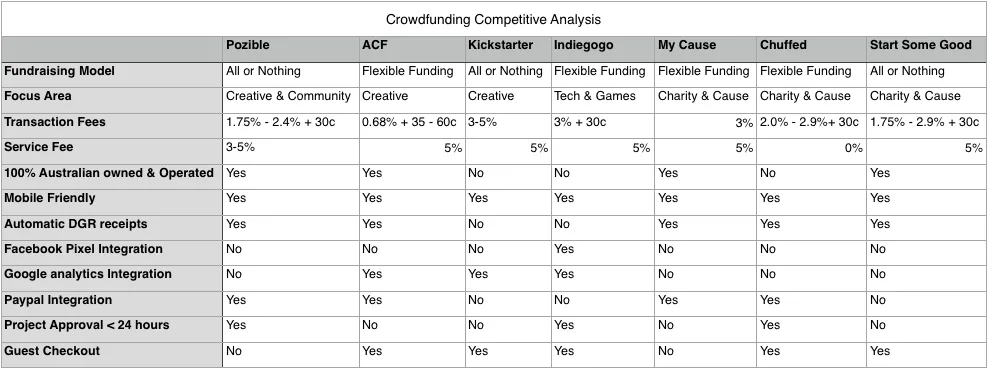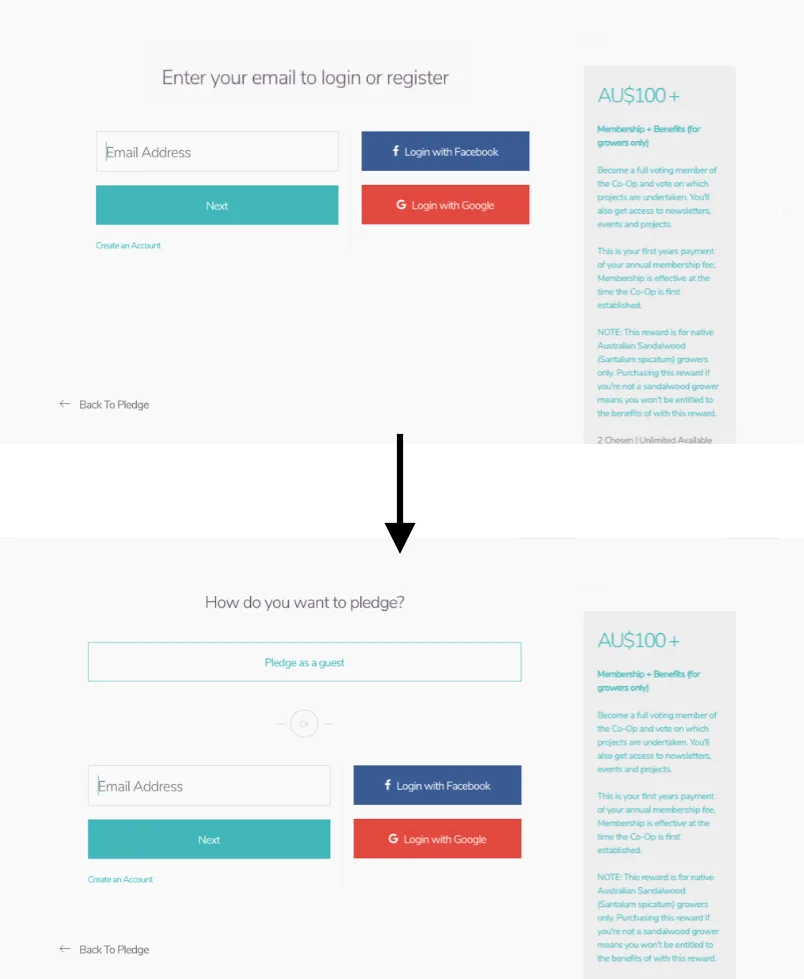
Simple Functionality Changes That Boosted Business
The Story
During my time at Pozible, Australia's biggest crowdfunding platform, we ran a number of initiatives and experiments, but this one is one of my favourites. It oulines the perfect blend between product and marketing. With large international competitors like Kickstater we had to be creative to hold our local turf.
Competitve Analysis
It’s too easy to get complacent and hide behind a successful brand. Your critical mass and brand awareness brings leads effortlessly.
But in any space that’s worth having, there’s always going to be stiff competition. You’re always going to be in a race. SAAS products differ from most others, they’re incredibly easy to sign up to and join, and equally as easy to leave. This makes for an uncertain landscape, one in which no company should feel comfortable with “business as usual”.Sizing your service up based off functionality you offer is very important. Using quantitative or measures is also important as often, you’re in love with your product. Like a mother with her child you’ll defend it to the grave. qualitative measures won’t give you an honest comparison.
This is when we undertook a full functionality audit. We’d look at other platforms and see what they were offering, and here’s what we found.
We tabulated all this data with the platform plotted at the top, and the functionality plotted down the side. When we’d finished we didn’t have a positive result, we ended up with a table we didn’t like. For example, we wouldn’t share this table publicly on our website, and that was saying something. From a functionality standpoint we were no longer competitive. Other services offer much more than ours. This gave us a good starting point to work from. The goal was to be the best platform of the table. So we started straight away.

I brought the team together to compile user stories, define the ‘definition of done’ for these stories and play planning poker. Normally in product development it’s important to tackle the riskiest and most valuable functionality first. But sometimes you just need to get the easy wins out to production as early as possible.
For this reason, we implemented guest checkout first. We deemed it to have the biggest positive absolute impact on users, and also be a selling point for our direct customers (Project Creators).
Guest Checkout
We’d been fighting this change of some time. We always told ourselves that social media login made thing easy enough. But after some heated discussion, the consensus was that people wanted a feeling of non-commitment, the actual reality of it didn’t matter so much. Another thing was that social media platform like Facebook were starting to enter a negative press cycle (which they’re still in now). Finally, we realised as a supporter that the advantage to having an account was being able to track an edit a pledge, that was it. It’s not a very big advantage, very little accounts would edit a pledge after they made it, less than 4% according to our research.
The best way to move forward was to maintain our architecture as closely as possible. From an architectural standpoint not much would change. User data would still be added to the “pledges” table of our database, but with two small differences; not all accounts would have a password, all accounts would include a new boolean field which defined if they were a guest or not.
Then we had to consider all the possible ways a user would interact with the platform
Users who already signed up (either directly or via social media)
For this we decided a user couldn’t move backwards, they couldn’t have a full account and use the same address to pledge as a guest. They’d be prompted to enter their password if they tried to pledge as a guest.
Guest users returning to sign up for a full account.
This accounted for the 4% of users stated above. These users wanted to alter a pledge of theirs. We could easily retrofit this to the “reset your password” functionality.
Guest users making another guest pledge.
Basically, they had a user account without really knowing it. All their pledges would be attributed to their email address. Should they one day sign up for a full account, then they would find all their previous guest pledges.

Next we looked at more ways to get an edge. So I asked the support staff to look through their “macros” in Zendesk and see which related to functionality. These Macros are just pre-written responses for support tickets. The support staff found that lots of budding campaigners asked about what kind of access they’d have to their supporter data. This was actually functionality we already had that we didn’t outline well enough.
Next we found a lot of campaigners that were already successful asked if they could increase their target once they were successful (provided they had a decent amount of time remaining on their campaign). Upon closer inspection we found that users were posting project updates with new targets. People were using our platform in a way we hadn’t catered for. This reminded me of the how Twitter’s retweet function was born. It was actually user generated. Users would re-post a tweet by copy pasting it and writing “RT” at the start. Until the team noticed and implemented formal functionality for this.
Customer Driven Functionality
Next we looked at more ways to get an edge. So I asked the support staff to look through their “macros” in Zendesk and see which related to functionality. These Macros are basically just pre-written responses for support tickets. The support staff found that lots of budding campaigners asked about what kind of access they’d have to their supporter data. This was actually functionality we already had that we didn’t outline well enough.
Next we found a lot of campaigners that were already successful asked if they could increase their target once they were successful (provided they had a decent amount of time remaining on their campaign). Upon closer inspection we found that users were posting project updates with new targets. People were using our platform in a way we hadn’t catered for. This reminded me of the how Twitter’s retweet function was born. It was actually user generated. Users would re-post a tweet by copy pasting it and writing “RT” at the start. Until the team noticed and implemented formal functionality for this.
So we implemented a ’Stretch Target’ function. This allowed users who had already reached their financial target to set a new higher target. This had a much bigger business benefit than we initially thought. As an all or Nothing crowdfunding platform we’d lose our service fee for unsuccessful projects. Essentially campaigners who set their target too high would end up being unsuccessful. This allowed our success team to advise campaigners to start smaller. This lifted our average success rate by 3% and raised the average a campaign raises by $350. This one feature brought in more revenue directly.. In retrospect this should have been built before Guest Checkout…
On top of this we added some other advanced marketing features like Facebook Pixel and Google Analytics.
This raised conversions by 0.8%, which for the compared periods below would equate to 270 extra conversions.
Spin-Off Marketing Campaign
Finally we got to the point we were happy. We looked back at our table and could honestly say to ourselves our service stacked up the best! We created a page that outline these new features and highlighted a few other things users frequently asked.
So with this we launched an Adwords marketing campaign called “Choosing The Right Platform”. We’d start budding campaigners on their customer journey with an Adwords campaign, targeting keywords of our competitors. It was safe to say that users who viewed this page had intentions of running a campaign. So the next step was re-marketing with social ads to visitors of the “compare” page..
This is a perfectly balance business initiative in my opinion.. It balances out product and marketing perfectly. Too many companies put too much into marketing without a compelling product, users aren’t stupid. On the other end of the spectrum, too many companies put too much money into product without any marketing, which results in their ideas being stolen by larger competitors.